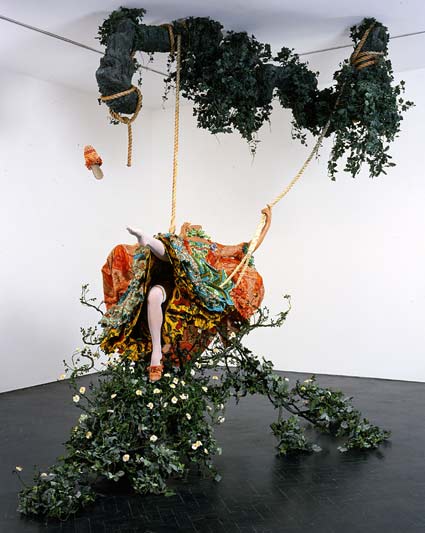
Yinka Shonibare, MBE (b. United Kingdom, 1962), "Diary of a Victorian Dandy: 17.00 hours," 1998. Chromogenic photograph, 72 x 90 in. Collections of Peter Norton and Eileen Harris Norton, Santa Monica. Image courtesy of the artist, Stephen Friedman Gallery, London, and James Cohan Gallery, New York. © The Artist.
Yinka Shonibare MBE (Season 5) has a mid-career retrospective currently on view at the Brooklyn Museum through September 20, 2009. The exhibition was organized and toured by the Museum of Contemporary Art, Sydney, Australia and after the Brooklyn Museum’s presentation it will travel to the National Museum of African Art, Smithsonian Institution, Washington, D.C.
The installation at the Brooklyn Museum is sprawling and elegant. Much of Shonibare’s work is rooted in art historical, historical, and literary references, making it all that more intriguing from a contemporary standpoint. Although installed on two floors of the Museum, the exhibition definitely has a sense of cohesiveness thanks to the poppy pink color used throughout the installation, which in turn echoes the catalogue design.
Shonibare’s work, according to the Museum’s press release, grapples with the relationship of contemporary African identity to European colonialism and explores themes of frivolity and excess. Much of the work in the exhibition deals with the 18th and 19th century, at the height of Victorian splendor—something the artist critiques throughout his work. Such is the case with Diary of a Victorian Dandy, based on a series of works by William Hogarth that depicted characters encountering some kind of social evil; in Shonibare’s version, the artist also appears as a photographic version of Oscar Wilde’s character, Dorian Gray.
Interestingly the critical reception of the exhibition has not been altogether favorable. In a Time Out review, Howard Halle mentions his first encounter with Shonibare’s work ten years prior. At that time, “the politics of identity still carried some urgency. Since then, the world has moved on while Shonibare, judging from this mid-career survey, has not.” And Karen Rosenberg’s review for The New York Times was equally ambivalent when she ended the review by writing, “But this artist, now on a world stage, needs to challenge himself and his audience.” However, Rosenberg was nonetheless able to find some relevance to contemporary society in Shonibare’s work when she wrote, “It doesn’t hurt that he is attracted to scenes of frivolity and excess, some of which resonate in the current economic climate. The figures in his installation Scramble for Africa are meant to be heads of state divvying up a continent, but they might as well be corporate titans at an investment bank board meeting.”

Yinka Shonibare, MBE (b. United Kingdom, 1962), "The Swing (after Fragonard)," 2001. Collection of Tate Britain (purchased 2002). Courtesy the Artist and Stephen Friedman Gallery, London.
Yet, one of the more discussed works in the exhibition, The Swing (After Fragonard) (2001), seems to resonate with critics. In the video theEye: Yinka Shonibare (2004), talks about his appropriation of the imagery of Jean Honoré Fragonard’s The Swing, (1766). Shonibare says that it is the naughtiness of the work that most interested him and that the painting reflects aristocratic decadence to its extreme. It was this idea he said that he wanted to work with in a contemporary way. But it is the very way in which he contemporizes the work that is problematic.
In fact, if you have seen the original, you will know that Shonibare took liberties with his interpretation. Several figures from the original are missing, namely the priest swinging the girl and her lover who looks up at her from below. In Shonibare’s version, only the girl remains, headless, dressed in the artist’s signature use of Dutch wax printed fabrics. Of this work, Halle wrote in his Time Out review, “In Shonibare’s version, the mystique of paint is replaced by the dull materialism of actual objects standing in for key elements in Fragonard’s canvas….Here, the French artist’s high-cultural porn has been subsumed to deliver a message about globalism.”
Indeed, it is the constant message of frivolity and excess and the critique of a certain era in history that runs through most of Shonibare’s work. He tweaks and plays with these themes differently, but the message is always the same. In The Times, Rosenberg reduces his work down to the following, “Once you grasp the essential conceit of his art—that his costumes for the 19th- or 18th-century ruling class are made from 20th-century fabrics associated with Africa—the rest is window dressing.”
Seeing the exhibition and reading what these critics have to say about it begs the question, “How is Shonibare’s work relevant to contemporary audiences?” Does the work still resonate? How does Shonibare’s appropriation of historical themes work in the context of contemporary society? Well, as Rosenberg duly noted, excess and frivolity play a role in today’s society—albeit in a different way—and have gotten the world into the economic trouble in which we now find ourselves. What is perhaps most intriguing is the way Rosenberg ended her review with a call to Shonibare to challenge himself and his audience. Given that this exhibition is a mid-career survey, it will be exciting to see how Shonibare’s work adapts and changes over time and in what direction his work will head in the future.
Erin Riley-Lopez is the Associate Curator at the Bronx Museum of the Arts.



